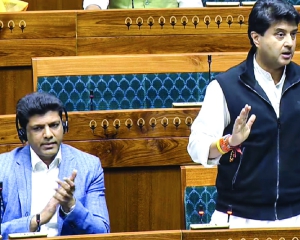His legacy, embodied in the Aga Khan Development Network, stands as a testament to pluralism and social upliftment, offering a model of progressive faith
World at large is suffering from acute polarisation based on religious fervour laced with extremism, supremacism and revisionism, across all faiths. This aggressive phenomenon when conflated with politics conjures a dangerous admixture of hatemongering, intolerance and ‘othering’.
Very rarely do such dark times lead to the positing of alternatives that bear progressive and reformist interpretations of faith, inter-faith dialogues, and celebration of the proverbial ‘other’. One relatively small sect (estimated globally at about 20 million) that defied this regressive trend has been the Ismaili Muslims, led by their spiritual leader, Aga Khan, an honorific title held by the hereditary Imam of the Nizari Ismaili Shias.
Recently the 49th Imam, Prince Shah Karim al Husseini, Aga Khan IV (revered as Mawlana Hazar Imam, by his adherents), passed away peacefully, leaving the world poorer with the loss of the rare ‘bridge’ in the divided world of faiths. He was a shining and rare example of how faith could be led to coexist in complete harmony with modernity, tolerance and large purposes in life. He defied so many stereotypes of religious leaders as he seamlessly connected the seemingly disconnected world of Ummah (Muslim world) with other faiths, the proverbial ‘East’ with the ‘West’, and even the sense of connecting the spiritual with the material, without ever losing the essential essence and benefit to humankind.
The wise leader of his faith always chose the nobler path of dialogue, inclusion and even protection of the ‘other’ with his foremost organisation, Aga Khan Development Network, employing over 96,000 people in 30 countries towards community work.
As his foundation noted, “Throughout his life, His Highness emphasised the view of Islam as a thinking, spiritual faith: one that teaches compassion and tolerance and that upholds the dignity of humankind. As such, pluralism – the embrace and celebration of diversity – has formed a central pillar of the Ismaili Imamat’s workâ€. Delhi itself is witness to the yeoman service in restoring historical sites like the Humayun Tomb, Sunder Nursery, Hazrat Nizamuddin Basti and Abdur Rahim Khan-i-Khanan’s Mausoleum. Their societal impact in reaching out to unseen millions with initiatives on health and nutrition, education, early childhood development, agriculture and food security, climate resilience, or even in the space of enterprise, is unprecedented in walking the talk of pluralism and social service.
Even though the larger fount of Islam is going through a crisis of sectarian tensions – the sect led by Aga Khan constantly guided his adherents towards education, employability and peaceful coexistence with all other faiths. Sadly, such progressive anchorage and beliefs also led many within the Ummah to declare the Ismailis as apostates. Ironically no place personifies that dichotomy within faith than Pakistan itself, whose father of the nation, Mohammed Ali Jinnah, was an Ismaili.
It is said Agha Khan I himself gave the name ‘Mohammed Ali’ to Qaid-e-Azam – however today Ismailis are now openly persecuted and discriminated against within Pakistan. They have even attempted to rewrite history by suggesting that Jinnah had opted to practice Sunni Islam by the end of his life! However, such open diminishment by the other majority strains of Islam has never stopped the Ismailis under Aga Khan to continue investing selflessly in things like Universities, Health facilities, rural support programs etc., be it Pakistan, or even in Afghanistan, where the Aga Khan Development Network remains committed with relief work, socio-economic projects and restoration work, despite the puritanical and discriminatory outlook of the Taliban.
It is little wonder that the Indian Sub-Continent (home to the largest presence of Ismailis) has given a large number of Ismailis of eminence like entrepreneur-philanthropist Azim Premji, nuclear physicist-commentator Pervez Hoodbhoy, painter-filmmaker Tyeb Mehta, jurist-diplomat MC Chagla, Indian Air Force Chief Idris Hasan Latif, journalist-activist Sharmeen Obaid etc., proving how the community always punched above its weight in terms of population numbers. Befittingly, the Indian Prime Minister condoled the passing away of Aga Khan IV by recollecting, “He was a visionary, who dedicated his life to service and spirituality.
His contributions in areas like health, education, rural development and women empowerment will continue to inspire several people.†Earlier in 2015, the Indian Government had conferred the Padma Vibhushan to Aga Khan IV.
Given the bitter politics and narratives of the day that seek to ‘divide’ rather than ‘unite’ each other – the Aga Khanis are a glorious example of the model citizenry that is inclusive, progressive and concerned about the future, and not just mired in the darkness of the past.
The forward-looking moorings were perhaps institutionalised with the selection of a twenty-one year Aga Khan IV (by his grandfather) overlooking his father, “in view of the altered conditions in the world in very recent years, including the discoveries of atomic sciences, I am convinced that it is in the best interest of the Shia Muslim Ismailian Community that I should be succeeded by a young manâ€, and therefore the “Imam of the atomic age†lived up to his credo and expected anchorage.
Today the mantle passes on to his son, Prince Rahim Aga Khan, to continue providing that hope and direction not just to Ismailis, but also to the larger comity of Ummah and mankind, to still persevere with hope in interfaith dialogue and collective progress, as an investable possibility.
(The writer, a military veteran, is a former Lt Governor of Andaman & Nicobar Islands and Puducherry. The views expressed are personal)



























